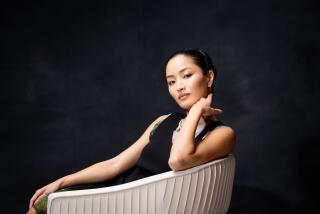Imperial Traditions Reign for the Newest Little Royal in Japan
- Share via
TOKYO — Perhaps the only thing Crown Princess Masako--a respected former diplomat and Harvard graduate--has done in eight years to shake things up in Japan’s crusty imperial household is something very traditional.
She delivered a baby girl.
The littlest princess, born Saturday in an event that was treated somewhat like a Second Coming here, is the third granddaughter of Emperor Akihito and his wife, Michiko. No male heirs have been born since Crown Prince Naruhito’s younger brother, Akishino, arrived in 1965.
It might have been easier had Masako given birth to a long-hoped-for male heir to the 2,600-year-old Chrysanthemum Throne, which by current law cannot have a female occupant. A boy would have eliminated the pressure on Masako, 37, to produce a male successor.
But the birth has revived talk of changing the law to allow a woman to ascend: The baby girl is the first child of the crown prince, the eldest son of the emperor and next in line for the throne.
Even though the emperor plays a largely ceremonial role in Japan these days, any changes in the ascendancy law would be highly controversial in this land where gender roles tend to be clearly divided and some people still consider the emperor to be divine, as was widely believed before the nation’s World War II defeat.
When questioned by reporters Saturday, Prime Minister Junichiro Koizumi dismissed any discussions of changing the law as “premature.”
But the fact that the career-oriented Masako, who was a most untraditional choice to be crown princess, hasn’t been able to change the imperial palace shows how tradition-bound the royal family is. Once said to be feisty and independent, the married Masako is seen only occasionally, waving politely and speaking demurely, conservatively though beautifully clad in suits and dresses with matching pillbox hats and clutches.
In fact, Masako and the crown prince don’t even get to choose their child’s name. That’s the job of the emperor.
Much of the rest of the little princess’ childhood is likely to be controlled not by her parents’ dictates but by tradition, along with the rules of the formidable bureaucratic Imperial Household Agency. Unlike the British princes William and Harry, she’s unlikely to be able to stop in at fast-food restaurants or go to theme parks. The best she might hope for is a year abroad at a college such as Oxford, which her father attended.
The baby got her initial taste of those rules in the first few hours of life--with the ritual shiken, or “giving of the sword,” ceremony that must be performed within 24 hours of birth. A sword of protection--made for the occasion by Sadao Osumi, 68, one of Japan’s two “living national treasures” of sword craft--was placed on the baby’s pillow, along with a hakama, or divided skirt.
Today comes the “congratulatory visiting” by the imperial family, the prime minister and other luminaries, with strictly prescribed hours that relate to the time of birth. Then, a day later, congratulatory visits by select “common people” are allowed.
On the seventh day after birth, at precisely 9 a.m., comes the bathing ritual, in which the baby is washed in a cedar tub so that evil is banished, and prayers are offered for her health.
Then, at 11 a.m., the emperor will deliver his name choice, on a piece of paper enclosed in a special black lacquer box. A special committee of scholars has already submitted a list of recommended names, and it’s said that the emperor has already chosen one.
Despite all the rules and rituals, the typically reserved Japanese seemed noticeably more buoyant after the baby’s birth Saturday afternoon.
People rushed to newsstands to get free copies of special editions hot off the presses; thousands hoisted lanterns and flags in parades throughout the country; congratulatory banners hung from snowy Hokkaido island in the north to sunny Kyushu in the south; and men and women spoke of how the baby was a bright light in a period of economic gloom.
No one who turned on a TV could escape the footage, played over and over again, of the beautifully groomed Masako--beaming as if she were going to a festival--as she was driven to the hospital late Friday.
Japan seemed to pause for just a second when the nation heard that it was a girl. Then it enthusiastically embraced the news of a healthy child. It had been widely speculated that Masako would have a boy--mostly because official discussions had stopped a few months ago about changing the law to allow a woman to become the top royal.
Sports tabloid Nikkan Shukan seemed to capture the feeling in a huge headline on an extra edition with a single kanji character: onna, meaning female.
“Since they all talked about a boy, a girl will be much more interesting,” said freelance illustrator Akiko Yoshida, 39. “Maybe she can be an empress.”
Even if that doesn’t happen, it’s possible that Masako--who speaks at least four languages--might bring some changes to the child’s upbringing.
Her mother-in-law, Empress Michiko, did. Like Masako, Michiko was a commoner, and she shocked Japanese society when, as she emerged from the hospital after Naruhito’s birth, she took the infant from a lady-in-waiting into her own arms.
Another shock came when she chose to breast-feed her child, something Masako also plans to do.
But the rules of the household later apparently broke Michiko, who became empress when her husband ascended to the throne in 1989. Insiders say she suffered a breakdown under the constant scrutiny, although she is said to be fine now.
If the ascension law is not changed, and if the new baby grows up and marries a commoner, she too will become a commoner.
More to Read
Sign up for Essential California
The most important California stories and recommendations in your inbox every morning.
You may occasionally receive promotional content from the Los Angeles Times.












